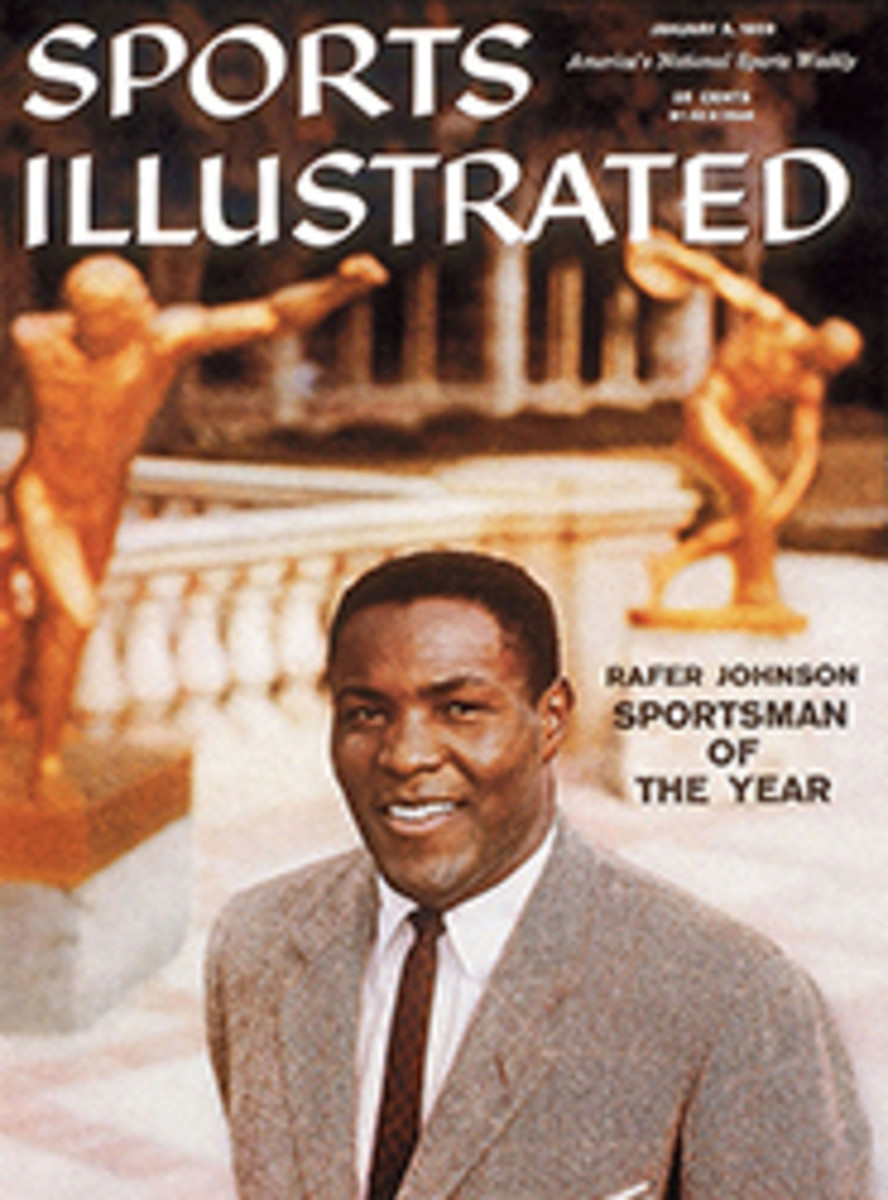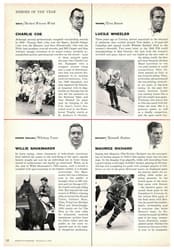
SURRENDER AT NOTRE DAME
It was only last month that Moose Krause, athletic director of Notre Dame University, assured a gathering of Chicago sportswriters that "Terry Brennan was a better coach this season than he was last year, and he will be at Notre Dame for many, many years to come."
Although there were rumbles of discontent from Notre Dame alumni over the fair-to-middling 6-4 season just completed, the writers had no reason to doubt Krause's statement. The 1958 Irish, while not measuring up to the formidable standards of Rockne- and Leahy-coached teams, still played exciting football, drew near-record crowds and always stayed within striking distance of victory even in the four games they lost. More important, the team and its coach seemed to fit well into a university whose president, the Rev. Theodore M. Hesburgh, has been striving mightily to raise academic standards, gain prestige and place football in its proper status in university affairs: an important but not domineering force.
On December 11, at a football team banquet, the university's executive vice-president, the Rev. Edmund P. Joyce, indicated that the administration was taking the team's four losses philosophically. Father Joyce, who is also chairman of the Faculty Board for Athletic Control, admitted that the season "was disappointing" but firmly said that "Notre Dame will continue to field teams in the proper educational atmosphere."
On the evening of December 16, 30-year-old Terry Brennan was entertaining a few friends in his modest white frame house in South Bend when the telephone rang. It was Father Joyce. The message: the faculty board had recommended Brennan's release. Stunned, Brennan agreed to keep the firing secret until the following Sunday but flatly turned down an offer to resign: "That might look as if I were quitting and running out, and that isn't the way it was at all."
On Sunday, four days before Christmas, Notre Dame announced Brennan's dismissal. It also released a letter from Father Hesburgh. "It is with great reluctance that I accept this recommendation," he wrote to Brennan. "In the five years that you have been head football coach...you have impressed all of us as the kind of young man Notre Dame aspires to produce." But what young Terry Brennan had obviously failed to produce was enough victories.
In the days before Brennan, South Bend wags will tell you, there were only three rules a coach had to obey to keep his job: 1) Win every game. 2) Win by more than the betting point spread. 3) Gain the No. 1 rating in the nation. And the wags will wink and tell you that one reason why Frank Leahy left is that a fourth rule was written in when Father Hesburgh became president in 1952. The fourth: Obey the other three if you can but do it with A students. In fairness to Father Hesburgh it must be reported that he would have liked to erase Rules 1 to 3, but even the president of Notre Dame is only partially in control of its football fortunes. As for Rule 4, under Hesburgh's administration an athlete has been obliged to maintain, not an A average, of course, but a respectable 77%.
Young Terry Brennan was aware of the Rules when he took over for the 1954 season, but he believed he could field winning teams even within the Hesburgh framework. For the first two years he did just that, won nine games and lost one in 1954, won eight and lost but two in '55. But when the class of '56 was graduated, with it went the last of the players who had come to South Bend under the old Notre Dame recruiting tradition, and the next fall the Irish had the worst football season in their history, losing eight games and winning only two. Alumni screams arose calling for Brennan's dismissal. For two months the university's administration was silent, then tersely announced: "Terry Brennan has been re-engaged for another one-year period."
In the best of all possible worlds, a university ignores alumni when it thinks they are wrong. Compounding the sensitivity of Notre Dame's position, however, is the fact that the university is engaged in a $66 million fund drive, and the fund raisers have been running into an old fact: it is easier to raise money when you have a winning football team. The man in charge of the Notre Dame drive is the Rev. John J. Cavanaugh, Father Hesburgh's predecessor as president of the university. As early as September 1957 the Detroit Times, in a story by Sports Editor Ed Hayes, identified Father Cavanaugh as one of the men most anxious to see football changes. Prophetically the Times added: "The man they'd like to install as head coach is the veteran professional coach, Joe Kuharich, a former Notre Damer now head man for the Washington Redskins."
After the 1957 season cries came again for Brennan's removal. This time the university issued not a sentence on Brennan's status, and without even a written contract Brennan began to build a promising team including 25 veterans from the '57 squad which, after all, lost only three games and won seven, including a stirring victory over Army and an upset of Oklahoma, which had been unbeaten for 47 games. In 1957 Brennan had been lucky in the vital moments but in 1958 his luck invariably failed. Injuries to his key linemen kept the defense shaky, and 23 fumbles blunted the potentially great Irish attack.
There is little doubt that Terry Brennan considers his dismissal unfair, that he is disappointed, hurt and a little angry. He is also, like any reasonable man who has done his best, puzzled by the furor and the firing. "I think that Notre Dame will always have good football teams," said Brennan slowly and thoughtfully last week, "but I think that those who hope for a return of the good old days are being very unrealistic. Our overall policy here has been to aim in a certain direction educationally, and to get a winning team, too. I don't understand how I failed in that respect. Strange, strange business."
No one can say for certain what reasoning the Notre Dame athletic board followed in determining to fire Terry Brennan. So secret were the deliberations that Athletic Director Krause did not learn of Brennan's dismissal until Terry did. But what is certain is that the pressure for championship teams became so strong, both among the alumni and a faction of the faculty, that the administration was worried into doing something about it.
The problem actually could have been solved by an announcement that Notre Dame would immediately increase its recruiting and the number of football scholarships and lower the academic requirements for players. But such a candid solution would have been bad for public relations and might have destroyed the university's academic status so carefully raised by Father Hesburgh.
Another solution, more politic but dangerously ephemeral, would have been simply to fire Brennan and hire a high-powered coach, without changing the athletic scholarships, recruiting policy or academic standards. For a while the wolves would have been appeased, only to return in full pursuit in a year or so when the new coach failed to produce a championship team—a feat considered impossible with the material Notre Dame has been receiving for the past several years.
As it turned out, Notre Dame did indeed fire Brennan and hire Joe Kuharich of the Washington Redskins. No mention was publicly made about scholarships and recruiting and standards, but football observers thought it entirely unlikely that Kuharich would have left a five-year contract in Washington without assurances that he would have adequate scholarships and enough "academic risk" players to produce the kind of team that the more relentless Notre Dame alumni demand. Kuharich ticked off the players he wants: "Those dedicated to football—those with a deep-rooted love for the game—those who want to sacrifice and suffer for it."
But in trying to placate the Old Boys of Notre Dame probably no one in the university's administration anticipated the resentment that Brennan's firing would set off. All across the nation editors, sports columnists, football coaches and even Brennan's players condemned the Notre Dame action. Louisiana State's young Paul Dietzel, the 1958 Coach of the Year, said evenly: "Anyone taking that job now should have his head examined. Firing Brennan will have the effect of setting back football 20 years at Notre Dame."
But setting it back 20 years—or 40 years—is precisely what the Old Boys seem to want. It is something unlikely to come about. What has come about, however, is a rebuff to the progress Father Hesburgh has made in balancing educational excellence with football prowess at Notre Dame. The real tragedy at South Bend goes beyond the unhappy denouement of the Notre Dame career of Terence Brennan, halfback and coach. The real tragedy is the reluctant surrender of the forces that worked for a sane athletic policy. In this respect, the most biting comment on Brennan's dismissal came, not from the platoons of sports editors and football coaches, but from a Catholic weekly newspaper. Wrote the Indiana Catholic and Record, official newspaper of the Archdiocese of Indianapolis: "The firing of Terry Brennan is a setback for the priests and laymen who are trying to remake the public image of Notre Dame from a football factory to a first-class university.... They are the ones who really lost."
PHOTO
OUSTED TERRY BRENNAN RIDES HIGH—BARELY YEAR AGO—AFTER NOTRE DAME UPSET LONG-UNBEATEN OKLAHOMA
PHOTO
COACH KUHARICH WANTS DEDICATED MEN
PHOTO
FATHER HESBURGH, Notre Dame president, accepted decision "with great reluctance."
PHOTO
FATHER JOYCE, university vice-president, chaired group that called for dismissal.
PHOTO
FATHER CAVANAUGH, chief fund-raiser, found his job hard in just-fair seasons.
PHOTO
When Notre Dame began its first season with Terry Brennan, President Hesburgh wrote for the readers of SPORTS ILLUSTRATED (Sept. 27, 1954) an ardent statement of the athletics philosophy of his administration. Excerpts:
We are in favor of intercollegiate athletics at Notre Dame...intercollegiate athletics within their proper dimensions...those of university life and purposes.
The passing mark at Notre Dame is 70%. Athletes must have a 77% average.... I remember receiving one bleak Friday afternoon [the semester grades] of two first-string basketball players who...had fallen below the required 77% average. A phone call followed to the Director of Athletics. "My gosh, Father," he moaned, "the team is just leaving for the toughest game of the season against Kentucky tomorrow. They'll be murdered without these men. If you send me word by mail, the normal way, I would get it Monday morning."
No one likes to be Simon Legree, but all I could say was, "You've got the word now. And I'm not so much worried about being murdered as about being right."
The least a university can do...is to tell its alumni and friends exactly where it stands.... The worst that a university can do is to play the three monkeys who see, hear, and speak no evil. I assume that with the pressures that do exist for winning teams, well-meaning but ill-advised alumni and friends will cut corners at times—but not for long unless a university insists on seeing and hearing nothing....
Directors of athletics and coaches [must not be] unmercifully pressured for victories.... Even football is still a game and one side always loses, even though we must always play the game to win.

